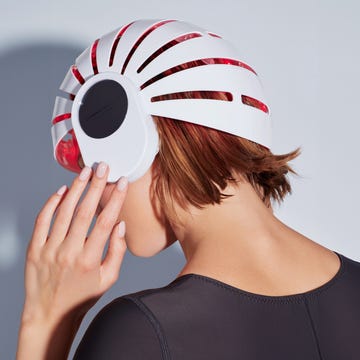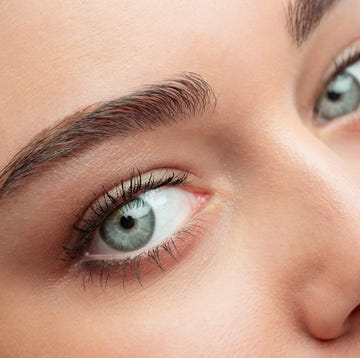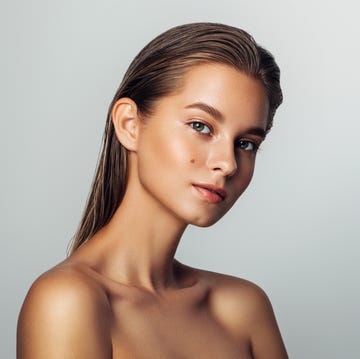If you’ve been on any form of social media lately, you’ve likely come across videos about skin cycling, a catchy term used to describe how and when to apply certain skincare products. As quickly as the term began to go viral on apps like TikTok, it's second cousin, hair cycling, is having a moment as well.
So what exactly is the viral hair trend all about? “Hair cycling is just a term that someone coined for creating a specific haircare routine, which is a good idea for people with all hair types and textures,” says Harry Josh, a celebrity hair stylist and founder of Harry Josh Pro Tools. You'll incorporate a specific number of products—from shampoos targeting your texture and needs to ultra-nourishing hair masks to hair oils—to get a mane that's silkier, shinier, and healthier. Who wouldn't want that?
Meet Our Experts: Harry Josh is celebrity hairstylist and founder of Harry Josh Pro Tools, Helen Reavey is a celebrity hair stylist, certified trichologist, and the founder of Act+Acre, Cataanda James, is a hair expert and brand educator at The Mane Choice
And while hair cycling is popular for a reason, there are a few things you should know before getting started. Read on for all things hair care and let’s get cycling!
What Is Hair Cycling?
Simply put, hair cycling is the process of creating a specific routine of shampoos, conditioner, and stylers to support your specific hair type and texture (even curly) to achieve your best hair, says Josh. “It's more than just having a favorite brand or go-to shampoo, it’s about having a weekly or monthly cycle of products that have different purposes but are all working together for the common goal of healthy, nourished hair,” he adds.
Your cycling regimen is unique to you and your hair, but it’s typically a four to five day routine that incorporates “rest days'' throughout the week, says Helen Reavey, a celebrity hair stylist, certified trichologist, and the founder of Act+Acre. This allows for your hair to breathe and repair itself after using products, cleansers, or masks, she explains.
[tiktokalign='center']https://www.tiktok.com/@kelseygriffinn/video/7156324658915216686[/tiktok]What Are The Benefits Of Hair Cycling?
According to Reavey, hair cycling minimizes irritation to the scalp from your products. “[It] reduces the potential risk of inflammation from active ingredients or products that have stripping ingredients such as sulfates and gives the hair a break from regularly using silicones, which tend to build up on the scalp and hair follicles, leaving them more susceptible to irritation,” she explains.
Not to mention, sticking to a set routine prevents you from overusing products—especially on your ends, which can cause hygral fatigue (damage to your hair follicles caused by repeated swelling and unswelling typically caused by over-conditioning), adds Reavey.
And, probably most appealing, is that a regular hair cycling routine may make a noticeable difference if you're experiencing hair thinning. That's because central to any hair cycling routine is an emphasis on scalp care—and when you nurture and care for your scalp, you should eventually notice that the hair that sprouts out of it is stronger and more resilient.
Who Should Try Hair Cycling?
The short answer is anyone with hair. Unlike other trends like hair contouring or glass hair, the hair cycling trend is great for any person who wants to improve their scalp and hair health, says Josh. In other words, you’re all invited to the party.
In terms of risks, there really are none. Just remember to not overdo it. “It can be tempting to form a 30-step hair routine with every product under the sun, but that can be more damaging to your hair and weigh down your strands,” says Josh. Instead, find a go-to shower and hair care routine, and stick to it.
What Is The Difference Between Hair Cycling And Skin Cycling?
Unlike skin cycling, which, as we've previously reported, is a very specific regimen that harnesses the powers of very targeted products and ingredients, hair cycling is much more personalized. The products you'll use are very specific to your type and texture—so someone with 4C curls may be using a completely different lineup from someone who has fine, straight hair who may be looking to add more volume.
How To Hair Cycle
First things first. Figure out your hair type and texture and consider your environment (think: is it humid and rainy or cold and dry?), says Josh. Then, create a schedule that works for you (and that you can stick to) and decide which days you will cleanse, clarify, condition, and mask. It may also take a few weeks to nail the perfect routine, so you can expect some trial and error. Find products you love, because once you establish what’s right for you, the benefits will start rolling in.
Everyone's hair is different, but here's a sample hair cycling schedule recommended by Reavey and Josh to get you started:
Exfoliate Your Scalp
This is key—you want to start your hair cycling routine with a clean slate. That involves using a gentle exfoliating treatment to remove product building up and break down oil. All of this gunk can clog hair follicles resulting in hair that's thinner and more fragile
Just remember to be careful, and to choose a gentle scalp scrub to exfoliate, because harsh scrubbing can cause micro-tears on the scalp and cause discomfort or infection.
Double Cleanse With A Gentle Shampoo
Double cleanse with a sulfate and synthetic-free shampoo. The first cleanse removes product build-up and the second purifies the scalp. “Washing daily really is optimal as most hair damage is done from styling, not from cleansing,” says Reavey. “It really is a myth that you shouldn’t wash your hair too often, because dead skin, pollution, and sweat can all contribute to the hair shaft weakening, which causes unhealthy hair growth.” If you workout regularly, live in a polluted environment, or have dandruff, then it's better to cleanse more often, she adds.
Break Out The Conditioner
It's best to go with a hydrating conditioner or a deep conditioner if you have curly hair. These ultra-nourishing formulas that focus on hydration, and are great for “moisture retention, rejuvenation, strengthening, restoration, and manageability,” explains Cataanda James, hair expert and brand educator at The Mane Choice.
According to James, you have options when it comes to choosing the best conditioners here. There are those formulated purely for moisture, those with protein, and then the 2-in-1 formulas. Moisture conditioners work to, you guessed, it hydrated hair and keep it nourished. Protein-based deep conditioners impart strength, especially if your strands have experienced “over manipulation from styling your natural texture and curls, or have undergone a chemical process,” James says. The 2-in-1 conditioners blend the two together to give the perfect treatment. These conditioners give hair strands a dose of protein so that it reaps all of the strengthening benefits while also receiving intense moisture.
Use a Thick Hair Mask
Hair masks work to lock moisture back into each strand. Think of them as an extra dose of moisture on top of your conditioner. They should help to battle frizz and flyaways and keep hair looking silky and soft.
Finish With A Serum Or Oil
Not only do hair oils and serums work overtime to lock in moisture and repair split ends, they seal hair's outer cuticle layer (it resembles a shingled roof and protects the inner cortex) so that your hair will look extra shiny.
If your hair tends to the naturally oily side and you feel an oil product will leave your locks too greasy, opt for a lighter-weight leave-in conditioner instead. They also tend to be moisture-rich, but have additional benefits, such as eliminating heat damage, smoothing frizz, and preventing breakage that may be caused by aggressive brushing, pulling your hair back too tightly, overusing heat tools, or sleeping on wet hair.
The Bottom Line On Hair Cycling
This process is a highly individualized one—the routine above is just a starting point. It may take some trial-and-error to zero in on the hair cycling regimen that will benefit your hair most. So experiment a little—you won't do any harm by trying out different products until you find the ones that give you the lush, shampoo-worthy hair of your dreams.
Andi Breitowich is a Chicago-based writer and graduate student at Northwestern Medill. She’s a mass consumer of social media and cares about women’s rights, holistic wellness, and non-stigmatizing reproductive care. As a former collegiate pole vaulter, she has a love for all things fitness and is currently obsessed with Peloton Tread workouts and hot yoga.
Brian Underwood is beauty director at Women’s Health, where he oversees content strategy for the brand across all platforms, including digital, print, and social. Underwood previously served as beauty and wellness director at Oprah Daily and O, The Oprah Magazine. During his tenure leading beauty content for the Oprah brand at Hearst, stories Underwood commissioned were awarded the Skin Cancer Foundation Media Award and a Fragrance Award for Editorial Excellence (his second). He was the launch Beauty Director of Dr. Oz THE GOOD LIFE, and has held additional editorial positions at Fitness, Organic Style, Good Housekeeping, Life & Style Weekly, and Woman’s Day and has written for Self, Shape, Seventeen, Redbook, Cosmopolitan, and many more. Underwood previously served on the Skin Cancer Foundation’s gala committee and as partnerships director of the Trans Beauty Clinic, a New York-based charitable organization that provided beauty services and workshops to the city’s trans community.













